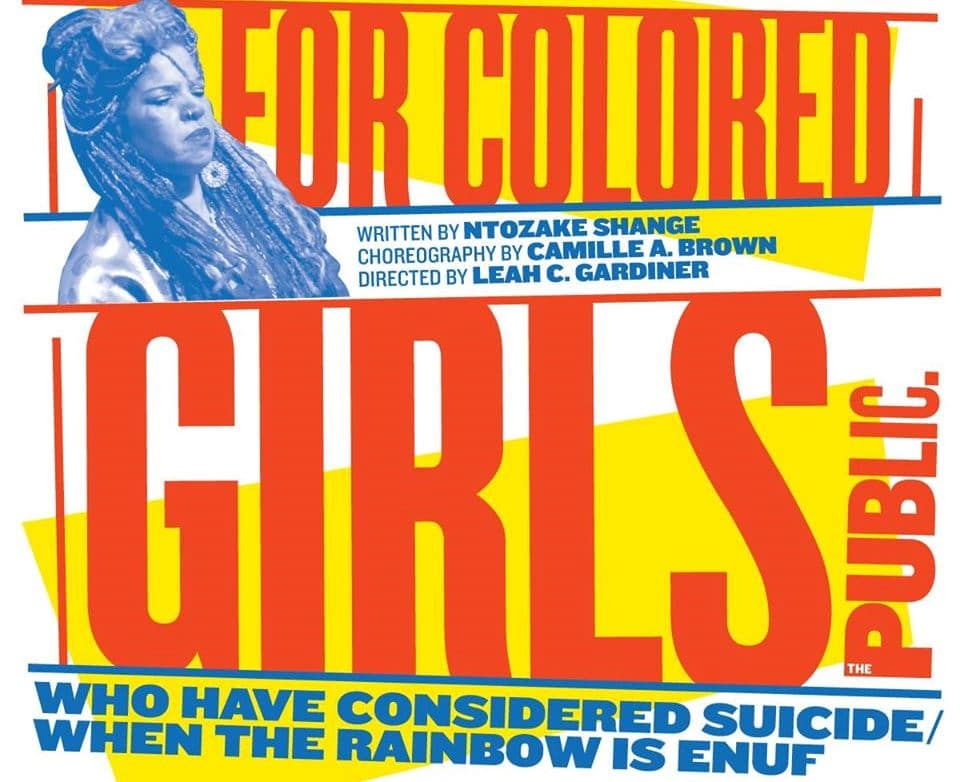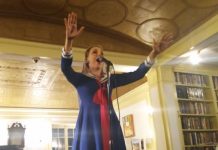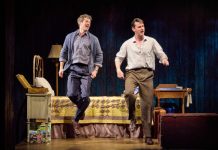First presented at The Public Theater in 1976, the Obie Award-winning For Colored Girls Who Have Considered Suicide/When the Rainbow Is Enuf, by playwright/poet Ntozake Shange – a pioneering voice in the Black Power and Feminist movements of the 20th century – is back where it premiered, for a limited-engagement revival (following Shange’s untimely death in 2018, at the age of 70) that’s already been extended twice. The breakthrough 20-part non-linear “choreopoem,” using a combination of poetry, song, and movement, features the stories of seven women of color who suffer the oppression of sexism and racism, but survive through the unity of sisterhood, their inner and outer strength and resilience, and increasing self-empowerment.

The intriguing title is derived from real episodes in Shange’s own life – four suicide attempts and an uplifting drive through a glorious double rainbow that re-awakened her desire to live. In the piece, the characters are identified not by their proper names, but by the different hues they wear – red, orange, yellow, green, blue, purple, and brown – to indicate the universality of their individual struggles and the beauty of their color. Directed by Obie Award winner Leah C. Gardiner and choreographed by Tony Award nominee Camille A. Brown, each Lady presents her experiences in a rotating series of monologues, dialogues, and group interactions, coming together in moments of pain and joy, to support and to celebrate one another.
Written in a realistic vernacular language and dialect, and incorporating passages in French and Spanish, the work employs the styles of direct address, free-verse poetry, storytelling, and re-enactments. Shange’s vital words are further enlivened by expressionistic interpretive moves set to a driving beat of live music (with music direction by Deah Love Harriott), body percussion, and a pre-recorded sound design (by Megumi Katayama), together encompassing African tribal rhythms, plantation songs (“Shortnin’ Bread”), pop hits (Martha and the Vandellas’ “Dancing in the Street”), and original compositions (by Martha Redbone).

The consistently outstanding cast – Sasha Allen as Lady in Blue, Celia Chevalier as Lady in Brown, Danaya Esperanza as Lady in Orange, Jayme Lawson as Lady in Red, Adrienne C. Moore as Lady in Yellow, Okwui Okpokwasili as Lady in Green, and Alexandria Wailes as Lady in Purple – delivers all the raw energy and passion, humor and pain, and ardent camaraderie to the characters, in their honest and emotional recollections of everything from sexual awakening to date rape, womanizing partners, abandonment, and domestic violence. They also bring powerhouse voices and electrifying physicality to their compelling and empathetic performances, with standout vocals by Allen, exuberant dancing by Moore, and exquisite movements by Wailes (who is deaf and alternates between speaking, signing, and eloquent motion).
In addition to the performers, the production also employs a creative team comprised of all women of color. Along with those cited above are Toni-Leslie James, who provides the rainbow of dresses that are meaningfully imprinted with silkscreened portraits of the predecessors the women most admire (an indication of their strong female lineage) and Myung Hee Cho, who creates a reflecting scenic design of mylar panels that surround the stage and seats, mobiles of clear plastic tubes that hang above, and a row of mirrored disco balls, all of which capture and disperse the restorative colorful lighting by Jiyoun Chang.
Despite its power, there are aspects of the 1970s period-piece that seem dated in light of subsequent advances in feminism and inclusivity. All of the women here are exclusively straight cis-gendered females who define themselves largely through their relationships with men, and there is a blanket stereotyping of white women as dispassionate (“so why don’t we go on ahead & be white then/and make everythin dry & abstract wit no rhythm & no/reelin for sheer sensual pleasure”), though human beings of any race or ethnicity would have a profound reaction to being raped or abused. And while the in-the-round format of the production evokes the unbreakable circle of women, the staging is generally directed forward, towards the main orchestra section of the house, rendering visibility and audibility sometimes unclear for the rest of the audience.
For Colored Girls Who Have Considered Suicide/When the Rainbow Is Enuf was a revolutionary work of art when it debuted in 1976, with its inventive structure and under-represented perspective. It continues to resonate in our present times by shining a spotlight on a momentous period in our recent history and promoting a visible presence for women of color in society and in the theater.
Running Time: Approximately one hour and 40 minutes, without intermission.





